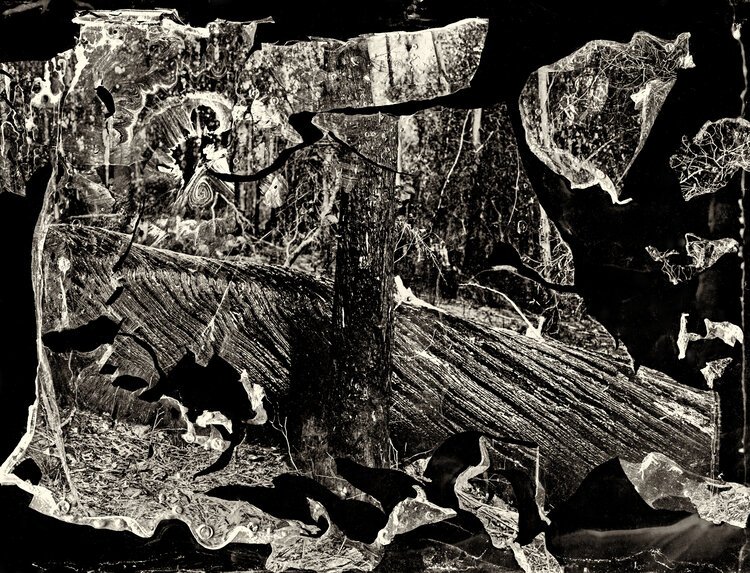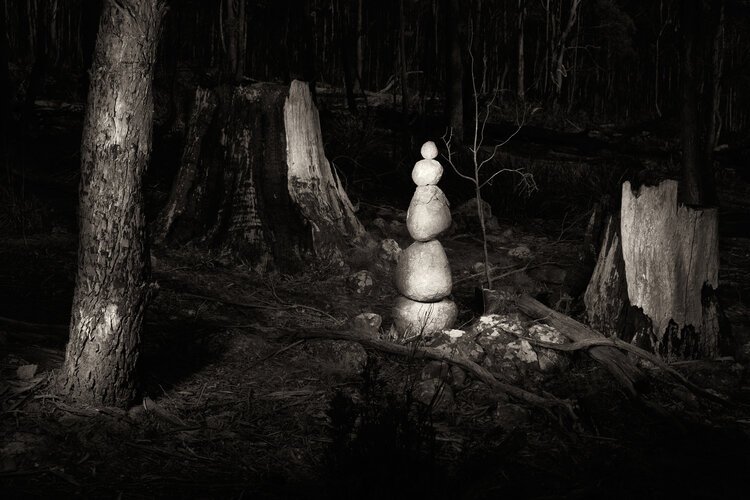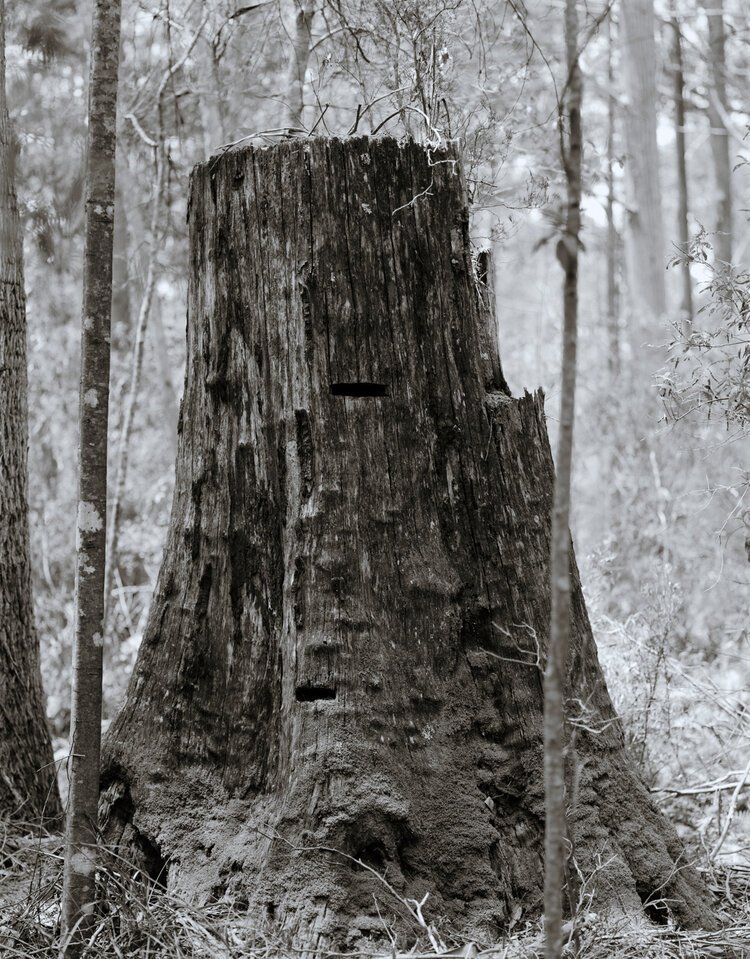Paying Attention - Offertory
Paying Attention - Residue
Video walk-through of Paying Attention exhibition

Ambrotype no.4 Coupe MM012E. 6.5x8.5" collodion glass negative.

Gorintō Coupe MM011D. Digital photograph

Giant stump Mt Morrison Block. 4x5" film photograph
PAYING ATTENTION
Salamanca Arts Centre Top Gallery
Feb 5-28 2020
Feb 5-28 2020
Paying Attention documents a durational performance comprising solo visits on foot and performances within Tasmanian native forests that were intensively logged for woodchips to supply the Japanese low quality paper industry.
I am paying attention to these otherwise overlooked, forlorn and ecologically ravaged, yet resilient and recuperating forests.
Paying Attention emerged from the sadness I feel exploring the vast area of production forest near my home that has suffered industrial scale clear-fell logging over the last half a century. I needed to come to terms with the grief I feel for this lost wilderness and to find hope for its recovery.
In each logging coupe I built a five stone Gorintō, emulating the Japanese buddhist pagoda that represents the elements: earth, water, fire, air and void.
These structures symbolise my hope that the forests will one day be whole again.
I sleep a night in each coupe beside the Gorintō. In each coupe I bury a book made of Japanese newspaper (the main use of the woodchips from these forests) that I bind using the traditional Japanese stab binding technique.
This interment symbolises a return to the forests, by way of loving gesture, the wood that was so violently and carelessly removed.
Some books are bound with a reciprocal and reparative gift of Kozo paper made from the Japanese mulberry tree, marked with charcoal gathered from burnt stumps in the logged coupes, applied in a medium of Japanese rice sticking paste. The books are buried with a handful of woodchips retrieved from the Triabunna mill where these forests were chipped en route to Japan. I also symbolically cremate a handful of these woodchips in each coupe.
Woodchips are thereby returned to the ground where the component elements can resume their cyclical journey in the forest ecosystem.
I made ambrotype photographic plates within coupes using a specially built darkroom that I carried on foot in to the forest. Ambrotypes are silver-based negative images on glass. They use one of the earliest photographic processes and were traditionally visualised in the positive using black velvet or black glass.
In respect for the logged forests, I use charcoal from burnt tree stumps within them, applied to Japanese Kozo paper, to visualise the forest ambrotypes.
I hope Paying Attention inspires consideration of our relationship with wild places; their intrinsic value, and their vulnerability.
~ ~ ~
This installation is part documentation, part resolved artwork. The digital video Paying Attention - Residue documents panoramically some of the logged forest coupes I visited; in many cases at dawn, after a night spent within the coupe.
The digital video Paying Attention - Offertory records some of my performative acts within the coupes using a technically innovative and, in itself performative approach: video recorded off the ground glass screen of the 100 year old camera I used to produce the wet plate collodion glass ambrotypes that also form part of this installation.
Technical limitations imposed by the old camera create a hauntingly altered psychology of space.
Three massive logged stumps, photographed on large format film, stand imposingly within the coupes bearing witness to a bygone time of selective, unmechanised logging.
They are sentinels of the ancient towering forests that covered this land when Europeans first arrived.
This project was conducted on palawa country in a manner respectful of their ancient occupation and stewardship of these lands.
Stuart Loone of the Spring Bay Mill kindly supplied woodchips from the remnant woodchip mountain. Maps of coupes and their modern logging histories in the Mt Morrison forest block, near Runnymede were provided by Forestry Tasmania (now calling itself Sustainable Timber Tasmania).
I am paying attention to these otherwise overlooked, forlorn and ecologically ravaged, yet resilient and recuperating forests.
Paying Attention emerged from the sadness I feel exploring the vast area of production forest near my home that has suffered industrial scale clear-fell logging over the last half a century. I needed to come to terms with the grief I feel for this lost wilderness and to find hope for its recovery.
In each logging coupe I built a five stone Gorintō, emulating the Japanese buddhist pagoda that represents the elements: earth, water, fire, air and void.
These structures symbolise my hope that the forests will one day be whole again.
I sleep a night in each coupe beside the Gorintō. In each coupe I bury a book made of Japanese newspaper (the main use of the woodchips from these forests) that I bind using the traditional Japanese stab binding technique.
This interment symbolises a return to the forests, by way of loving gesture, the wood that was so violently and carelessly removed.
Some books are bound with a reciprocal and reparative gift of Kozo paper made from the Japanese mulberry tree, marked with charcoal gathered from burnt stumps in the logged coupes, applied in a medium of Japanese rice sticking paste. The books are buried with a handful of woodchips retrieved from the Triabunna mill where these forests were chipped en route to Japan. I also symbolically cremate a handful of these woodchips in each coupe.
Woodchips are thereby returned to the ground where the component elements can resume their cyclical journey in the forest ecosystem.
I made ambrotype photographic plates within coupes using a specially built darkroom that I carried on foot in to the forest. Ambrotypes are silver-based negative images on glass. They use one of the earliest photographic processes and were traditionally visualised in the positive using black velvet or black glass.
In respect for the logged forests, I use charcoal from burnt tree stumps within them, applied to Japanese Kozo paper, to visualise the forest ambrotypes.
I hope Paying Attention inspires consideration of our relationship with wild places; their intrinsic value, and their vulnerability.
~ ~ ~
This installation is part documentation, part resolved artwork. The digital video Paying Attention - Residue documents panoramically some of the logged forest coupes I visited; in many cases at dawn, after a night spent within the coupe.
The digital video Paying Attention - Offertory records some of my performative acts within the coupes using a technically innovative and, in itself performative approach: video recorded off the ground glass screen of the 100 year old camera I used to produce the wet plate collodion glass ambrotypes that also form part of this installation.
Technical limitations imposed by the old camera create a hauntingly altered psychology of space.
Three massive logged stumps, photographed on large format film, stand imposingly within the coupes bearing witness to a bygone time of selective, unmechanised logging.
They are sentinels of the ancient towering forests that covered this land when Europeans first arrived.
This project was conducted on palawa country in a manner respectful of their ancient occupation and stewardship of these lands.
Stuart Loone of the Spring Bay Mill kindly supplied woodchips from the remnant woodchip mountain. Maps of coupes and their modern logging histories in the Mt Morrison forest block, near Runnymede were provided by Forestry Tasmania (now calling itself Sustainable Timber Tasmania).